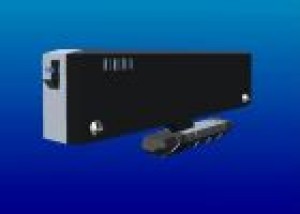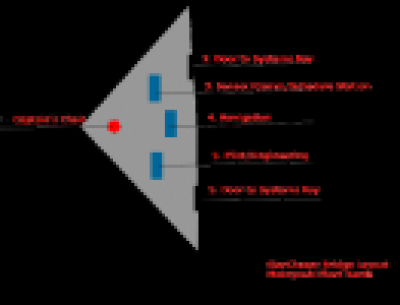Sidebar
Table of Contents
StarChaser Class Civilian Ferry
The first of a series of civilian ships designed by Motoyoshi Fleet Yards, a subsidiary company of NovaCorp; designed for the relatively moderate ranged 'puddle jumps' between the closely positioned systems in the Yugumo Cluster. Designed to be a commuter ship, appealing to the many entrepreneurs that are up and coming in the region.
History and Background
In YE 30, the Yugumo Cluster Civilian Transportation Authority (YCCTA) approached Koyanagi Mayumi, the new Director of Motoyoshi Fleet Yards with the need for a design that would economically fill the need to transport high volumes of civilians between colonies in the Yugumo Cluster on a daily basis. Koyanagi and her team responded with the 'StarChaser Ferry' design; a sleek, fast personnel transport with the services and comforts of commuters in mind.
Namesake
The name selected over a bottle of wine between Koyanagi Mayumi and her Chief Design Assistant, Thomas Mazu. The name selected for its sellability following a survey conducted a few months prior on civilians intending to relocate to the Yugumo Cluster region.
Design Goals
- Accommodations for 1000 commuters and their luggage.
- Low-Moderate Range.
- Communications and Data service for commuters.
- Design that will sell in markets outside of the initial region of use.
- Some level of protection from attack due to current war.
Statistical Data
General
Organizations Using This Vessel
Yamatai Star Empire (Yamatai Hoshi Teikoku) Yugumo Cluster Civilian Transportation Authority (YCCTA) NovaCorp Motoyoshi Fleet Yards
Vessel Role Classification
Civilian Commuter Transport
Class Designation
My-Y1-1a 'StarChaser Ferry'
Designers
Motoyoshi Fleet Yards, Civilian Products Division
Manufacturer
Production
Active
Price
Negotiable, depends on volume of sale.
Passengers & Crew
Personnel: 30 Recommended Capacity: 1000 Passengers Maximum Capacity: 1350
Vessel Dimensions
Length: 600m Width: 75m Height: 200m Decks: 3
- Deck 1: Bridge, Systems. Sub deck: First Class, Premium Services Kiosk
- Deck 2: Coach, Commuter Services Kiosk
- Deck 3: Engineering, Systems, Cargo
Appearance: Long tapered rectangle with rounded edges. Single CDD nacelle ventral surface

Thanks to SUBLIMEinal for the Artwork
Performance
Speed (CDD): 0.1c to 1000c Speed (Arial): 360km/hr Speed (Water): 8 knots
Range: Limited by the Lifespan of the vessel and sustainability of crew and passengers. 3 days of food and water for crew and 1000 passengers. Lifespan: Fifty years of continual use. Refit: 1 year refit cycle. Maintenance packages available for sale
Notable Internal Features
Deck One
Bridge

A simple triangular shaped bridge, with a captains chair facing inwards from the apex towards a group of central stations. Bridge stations include:
- Navigation
- Sensors/Comm/Schedule Ops
- Pilot/Engineering
Consoles and interfaces are simple touch response pads, the chairs are high backed padded leather ergonomically tested for superior comfort. The default color scheme is gray with blue accent and trim. Purchaser can request a customized scheme for additional cost.
Upper Systems Bay
Located aft of the bridge. The Upper systems bay is used to house the ship's sensor, communications, navigation and computing systems. The room is cramped due to the volume of electrical and data cables. A small area is usually set aside to accommodate crew members on their breaks, a simple table with chairs, vending machines, and some storage lockers. Emergency cots for the crew are also stored in this compartment. A central stairway descends down to the coach area and engineering sections.
Premium Services Kiosk
Designed to serve those passengers with money to spare. From slot machines,a small boutique selling Yugumo Cluster tourism collectibles, to a small cafe with sommelier service the premium service kiosk provides its customers with ample opportunities to cash in their credits and gorge themselves in luxury. Fee-based Hyperspace communication and data service booths are also available to passengers. Finely decorated restrooms are located on the starboard side. A central corridor from the aft section leads to the First Class Section.
First Class SubDeck
Seating for up to 300 passengers.The First Class Subdeck is down a few stairs from the central access corridor from the Premium service Kiosk. The chairs in this section are large, and comfortably padded leather, each complete with a volumetric projector for fee-based movies and entertainment as well as Hyperspace communications. The First Class section is designed to have wait staff service from the cafe, drop down tables are included on the back of each seat. Escape pods can be accessed on each side of the section. Restrooms are located off the aft section. Loading airlock is located centrally between the two restroom facilities.
Deck Two
Coach Passenger Section
Seating for up to 700; the Coach section has little to offer besides simple padded chairs, plain restrooms, and an in flight movie, or in some cases promotional commercial program for those who can see the screens at the forward-most part of the compartment. Restrooms are located both starboard and port aft as well as access to the Commuter Services Kiosk via a small passage way in between the two restrooms. Escape pods are accessible on both the port and starboard sides of the section. A central stairway leads up to the First Class Subdeck. Loading airlocks are located starboard-forward and port-forward.
Forward Landing
A small compartment where the stairs come down from the Upper Systems Bay and continue down to the Engineering Section. Crew-only access door leads into the Coach Passenger Section.
Commuter Services Kiosk
A small snack bar and information booth located aft of the Coach Passenger Section. Nothing fancy here; purchase connecting or future tickets, simple preprocessed food items from vending machines, ten fee-based hyperspace communications and data booths.
Deck Three
Engineering & Systems Bay
Section where the engineering crew manages the operation of the ship's systems; provides access to CDD, Waste Management, Life support, Power systems, etc.
Cargo Hold
A small cargo bay for the storage of luggage, supplies located aft of the Engineering Section. Airlock access is located on both the port and starboard side of the bay.
Notable Systems
Hull
- My-Y1-H3001 StarFerry Spaceframe Hull Construct
The primary spaceframe is constructed of titanium steel alloy truss frames interlocked together. These major trusses are arranged in higher concentration around the sections of the vessel that are most likely to become stressed like around the CDD nacelles, airlocks and to provide additional strength to areas such as the bridge and engineering. Force field generators are arranged at major truss junctions to provide additional strength.
The outer primary truss frames are plated with Depleted Uranium to provide a meager level of protection from attack.
Secondary framework is nested within the primary space frame to provide additional support and provide support for ships systems. The secondary frame is composed primarily of small steel alloy trusses and rods lined with steel meshing.
Armor Rating: DR 3
'Lollipop' Computer Suite
- My-Y1-E3001
A simple non-quantum computer system used to manage the ship's systems such as propulsion, navigation, sensors, communications, life support, etc.
Communications
The StarChaser Ferry is equipped with:
- Hyperspace communications
- Radio communications
- Laser communications
'Ripple' Economy Continuum Distortion Drive
- My-Y1-P3001
A budget model of the typical NovaCorp CDD unit. The drive generates continuum distortions and nesting them around the ship to create asymmetric peristaltic fields. This allows it to travel thousands of times the speed of light. Distortion based systems allow it to stop or move nearly instantly because the ship has not “moved” in the traditional sense. Designed with low maintenance, low cost and reliability in mind.
Shielding
- DR 3
Taking advantage of the fields generated by its CDD, a low end shielding effect is generated. Missiles, debris, energy and other matter is channeled along the field and away from the ship.
Waste Recycling System
- My-Y1-V3001
Takes wastes from drains, toilets and garbage receptacles extracts and purifies water and jettisons the remaining waste into space.
'Princess' Heavy Water Fusion-Fission Reactors
- My-Y1-G3001
The StarChaser is powered by two Heavy Water Fusion-Fission Reactors.
Weapons
None
OOC Notes
Page Tools
Terms of Service - Privacy Policy
